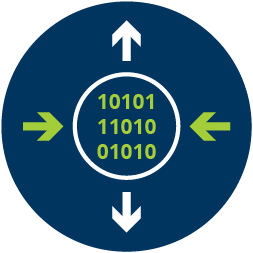
Integration of clinical systems
For example:
Video consultations for the diabetes service at Barts Health
A synchronous Nf2f clinic – requires the ability to undertake a real-time video-based discussion between consultant and patient. This has IT implications for both the hospital and the patient.
The East London CKD virtual e-clinics at the Royal London
An asynchronous Nf2f clinic – requires access to the local primary care system within a secondary care setting. See below for further details on the model.
Both examples demonstrate the need for IT considerations. Early engagement with your IT department and technical support teams is crucial to working collaboratively during the planning and implementation process. This will help identify and overcome potential barriers at an early stage.
In the planning section, you were encouraged to consider the roles and responsibilities of your key stakeholders. You may wish to re-visit this specifically for your IT department and consider establishing the roles and processes that support your work.
What do I need to consider when collaborating with the IT department?
There are many factors you’ll need to think about. First, take a look at the following case study to see how The Royal Free renal team worked alongside their IT department to design a solution for the Nf2f clinic.
What about interoperability and integrated care records (systems)?
Some Nf2f clinics will require IT systems with a specific level of interoperability and integration. For example:
East London CKD virtual e-clinics
East London CKD virtual e-clinics at the Royal London rely on nephrologists – who are based in secondary care settings – being able to access individual patient level primary care data.
These specialists then choose from the following options:
- Provide advice to the GP on the best course of management.
- Manage the patient remotely via the virtual e-clinic.
- Request that the patient is seen face-to-face.
A degree of interoperability is required to achieve this and run the clinic.
The Leeds Care Records
The use of integrated care records has been evaluated and demonstrated a range of benefits to both clinicians and patients. The Leeds Care Records is a good example of this. It was created by Leeds Teaching Hospitals NHS Trust and has shown a range of benefits, including:
- A reduction in contact with acute hospitals.
- Preventing duplicate tests and inappropriate treatments.
- Getting it right first time to minimise wasted resources.
- An improved patient experience, meaning people are more reassured and less resistant.
The positive benefits of an integrated system could also support the use of data across populations to better understand the impact of Nf2f clinics on health and care. For example, how has an Nf2f model impacted primary and secondary care following its implementation?
What are the key considerations?
If you believe that a level of interoperability is required, there’s a range of other issues you may wish to consider. The following list isn’t exhaustive, but it’s a good starting point as you plan to develop your own Nf2f clinics.

Integration of clinical systems |

Operational complexity |

Data sharing |
| How do clinical systems in different organisations currently share data with each other – if at all? What are the requirements to facilitate this? | What is the operational complexity and who will cover the financial requirements to support this work? | Does the scope of the data being shared allow each organisation to have full access to it? Is there a requirement to share the full patient record or can specific parts be shared? |

Task
Is there any work on integrated care records happening at regional level?
There are several regional collaborations across health, care and local authorities, supported by NHS England– these are called Local Health and Care Record Exemplars (LHCREs).
The One London LHCRE is focused on bringing together all parts of the capital’s health and social care system to connect services and integrate care. The aim is to design shared records for improving and coordinating individual care.
You may wish to consider linking with One London via your local STP. This might help you consider the requirements for your Nf2f clinic should it benefit from access to integrated care records (e.g. asynchronous models with requirements to access primary care data from within secondary care).